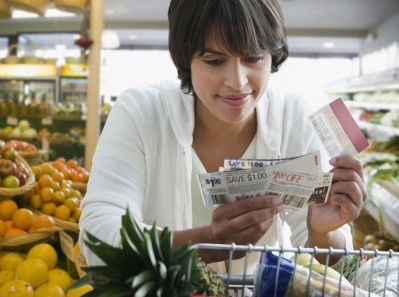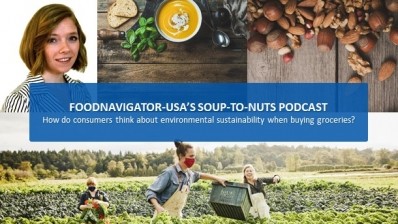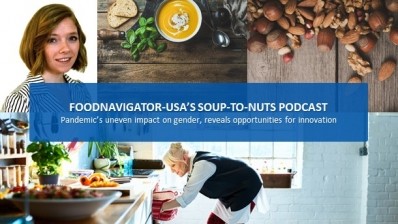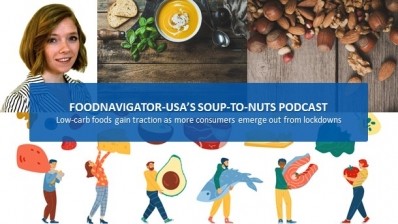Soup-To-Nuts Podcast: Consumer reliance on coupons rises with economic fallout from the pandemic
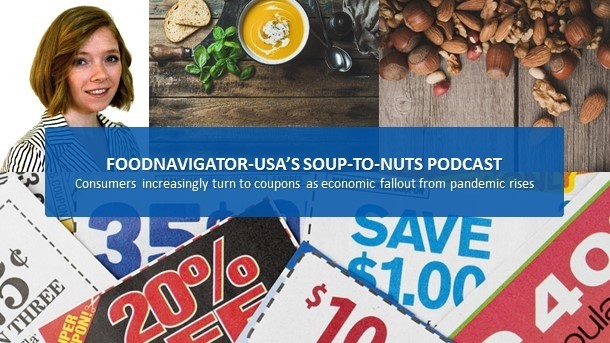
According to consumer research conducted by Valassis, online shopping and digital coupons are on the rise, but while paper coupons may be declining they still heavily influence what consumers buy and where they buy it.
Valassis’ survey of 1,000 consumers found after the coronavirus outbreak, the percentage of online grocery shoppers (defined as consumers who order groceries online for pickup or delivery) buying all or most of their groceries on the web climbed to 67% in 2020 from 58% the year before. It also found this percentage would be higher if they could use more coupons while shopping online. Specifically, 45% of consumers said they would shop online more if they could use more coupons – an increase from 37% in 2019.
But coupons aren’t just important to online shoppers. Valassis found 70% of consumers increased their savings behavior during the pandemic and 76% expect to continue these modified behaviors over the next year. This includes increased use of both paper and paperless coupons and discounts, which 60% of shoppers said they use to save money on groceries in 2020 compared to 53% in 2019.
To better understand how modern consumers are using coupons – both physically and digitally – and how retailers and brands can make the most of their promotional value post-pandemic, Sara Korab, retail trends director at Savings.com, shares in this episode of FoodNavigator-USA’s Soup-To-Nuts podcast recent consumer research conducted by the coupon aggregator. She shares details about who uses coupons and why, what types of promotions are most appealing, logistics considerations surrounding digital and physical coupons and what steps brands and retailers need to take to make the most of coupons in the modern era.
[Editor’s note: Never miss another episode of FoodNavigator-USA’s Soup-To-Nuts podcast – subscribe today.]
The evolution of coupons
While coupons have been part of everyday life since the late 1800s, Korab notes their use historically has surged during periods – like now – of economic instability and rapid technological advancement.
“Coupons started being a part of everyday life all the way back in the late 1800s,” with usage surging during the Great Depression and later during the Great Recession when consumers turned in earnest to coupon aggregation sites to find deals for everything they needed, she explained.
While most consumers now use their smartphones or the Internet to compare prices, find discounts and collect coupons, Korab notes that when it comes to food and beverage physical coupons are still important – making it vital that brands and retailers offer promotions different platforms and channels.
She noted that according to a survey of more than 1,000 US adults conducted by Savings.com, 79% of consumers looking food and beverage coupons still look for physical coupons, while 77% look for digital coupons.
“It’s getting pretty neck and neck there, and so I think it’s important for food and beverage” brands, retailers and restaurants to play in both spaces, she said.
In added that one of the most surprising aspects of the study was that 75% of consumers have downloaded an app for the express purpose of receiving coupons and deals, including coupon aggregators but also apps for specific retailers and even brands.
Younger consumers also frequently turn to influencers for coupons, and if they are not offered the “scroll right past,” Korab said.
Korab adds that brands and retailers working with influencers should not rely solely on discount codes, but should also work with influencers and bloggers to embed on their sites and in their feeds coupons that can be printed and taken to physical stores – some of which don’t have means for reimbursing digital discounts.
Make the most out of coupon campaigns by tailoring offers to consumer subsegments
When developing coupon campaigns, Korab notes that retailers and brands also must tailor the type of promotion to meet their target audience’s needs and preferences.
For example, she explains that while coupons are popular among consumers across demographics, they resonate best with younger consumers – especially Millennials who came of age during the recession and learned from an early age to search for discounts online before buying products.
“More than 40% of Millennials use coupon aggregators, often while shopping online, compared to just 33% of Generation X shoppers and 20% of baby boomers, which suggests that aggregators sites are effective when trying to reach younger shoppers,” Korab explained.
“In addition to that, we found with our survey that women are more likely to use coupon aggregators than men. So, 40% of them said they often or always use or search for coupons on aggregator sites when shopping compared to only 32% of men,” he added.
Likewise, different generations prefer different types of deals with older consumers preferring buy-one-get-one deals and younger shoppers gravitating towards a percent off coupon.
While buy-one-get-one and percent discounts are the most popular types of promotions for coupons, Savings.com’s survey found the least popular offers are for free shipping and rebates.
Technological barriers hold back coupon campaigns
While digital coupons are gaining popularity with consumers, brand and retailers, several limitations continue to hold them back and should be considered when creating a campaign. The most prominent among these, according to Korab, is that not all retailers can easily reimburse digital discounts and not all e-commerce sites can accept physical coupons.
“One thing that needs to be worked on a little bit from the grocery to CPG perspective is with so many people ordering groceries online during this time, there isn’t really a great process for applying physical coupons to those purchases,” such as loyalty coupons from a retailer, she explained.
She added that coupon aggregators and browser extensions also will remain, but need to evolve for easier mobile use.
Indeed, Savings.com projects nearly 80% of all coupon redemptions will come through mobile apps and surge to be worth $91bn in the near future – making this a worthwhile investment for brands and retailers alike.
